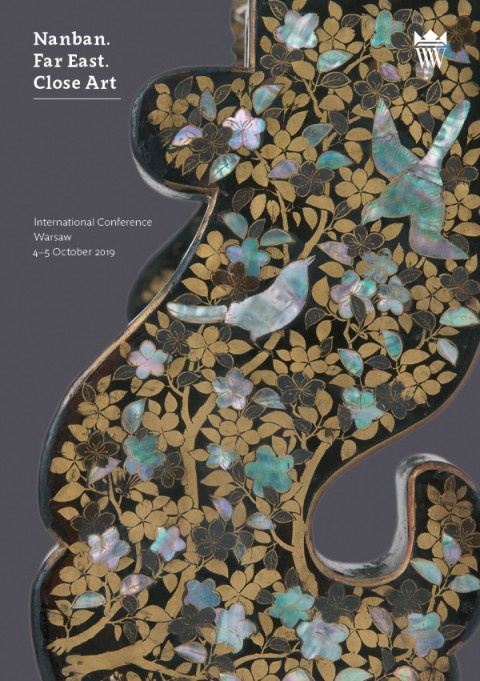International Conference "Nanban. Far East. Close Art", 4-5 October 2019

On October 4–5, 2019, the Museum of King Jan III's Palace at Wilanów hosted the International Conference “Nanban. Far East, Close Art”. The meeting has concluded the proj of the most valuable artefact from the historic Far Eastern collection at Wilanów – the Nanban table.
This piece of furniture, dating from around 1610, is an object of unique artistic quality, among the finest and most important surviving examples of Nanban style in the world. In its shape, it recalls late Renaissance Portuguese furniture, while its technique and decorations point to Japanese lacquerware (urushi) and Oriental traditions.
Ten years have passed since Victoria and Albert Museum undertook a major project of conservation of the Mazarin Chest (Japanese export lacquerware, ca. 1640). Preservation and conservation of Oriental lacquerware was and still is a challenge for specialists all over the world. The completion of the second project of that scale in Europe provides a great opportunity for deeper reflection on aspects of ethics and aesthetics, as well as the methods and materials used when conserving urushi.
The conservation of the Nanban table from the Wilanów collection provided an opportunity for interdisciplinary scientific research aimed at expanding knowledge about this unique object. The project also helped to expand the network of international specialists focused on Oriental lacquerware.
The symposium was attended by distinguished guests, authorities in the field of lacquerware: Prof. Dr. Monika Kopplin (Münster, Germany), Dr Masako Shôno-Sládek (Cologne, Germany) and urushi conservator Shigeru Kitamura (Nara, Japan). Museum staff and associates presented details of the Nanban Table Conservation Project. Other participants in the seminar were offered the opportunity to present their research and conservation projects during the poster session.
“The Collaborative Project of Conservation of the Nanban Table from the Collection of Museum of King Jan III’s Palace at Wilanów” was co-financed by a grant from the Sumitomo Foundation (Japan).
Curator of the conference:
Anna Guzowska
aguzowska[at]muzeum-wilanow.pl
The conference „Nanban. Far East. Close Art” was one of the events commemorating the 100th anniversary of the establishment of diplomatic relations between Poland and Japan in 2019
Conference materials for download:
- Programme of the conference
- Booklet Nanban. Far East. Close Art
- One hundred years of the urushi in Catalonia
- „Birdcage Vase” from the Dresden Porcelain Collection as an example of Japanese conservation techniques
- Flora Japonica. Botanical characteristics and symbolism of plants in Nanban table decorations from the Wilanów collection
- The Nanban Cabinet of the Kunsthistorisches Museum Wien. Analyses, conservation and restoration
- Changes in Western conservation and the Japanese reflection
- Filling lacunae: a possible approach to the conservation of an Oriental lacquer
- The PHySICAL project: Research protocol applied on a Japanese buddha statue
suggested

Conservation of a unique Nanban table from the Wilanów collection
Thanks to the financial support from the Japanese Sumitomo Foundation and cooperation between the Museum of King Jan III’s Palace at Wilanów with outstanding experts in Asian lacquer, it was possible to take the conservation works of the Nanban style seventeenth-century table in the Wilanów collection. It was one of the first conservation projects involving both Japanese and European specialists. It was part of cooperation started in the 1990s and involving science and conservation, between Japan and world institutions that keep in their collections artworks decorated with Oriental lacquer – unique witnesses of early modern contacts between East and West. Owing to exchange of experience and expertise, a strategy for the preservation of those very fragile Oriental artefacts has been devised.

Nanban-type table
Nanban, or the “art of the southern barbarians”, denotes sixteenth- and seventeenth-century Japanese works of decorative art, reflecting a discernible …

European and Oriental laquerware
Oriental lacquer constitutes one of the methods of decorating surfaces made of wood, bamboo, ceramics and papier mâché. Obtained from …

Fashion for Chinoiserie at Wilanów Palace
From the end of the seventeenth century Europe witnessed a growing fashion for Chinoiserie. Traces of this mode are to …

New exhibition at Chinese Cabinets – restoring the memory of the collections of Stanisław Kostka Potocki and his descendants
In 2019, a new exhibition commemorating the collector's passions of Stanisław Kostka Potocki and his descendants was opened at the …

















